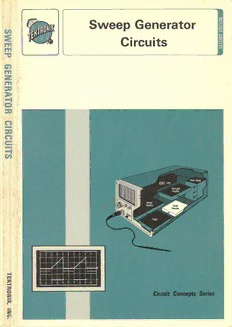
Sweep Generator Circuits PDF
Preview Sweep Generator Circuits
i, I ,iI ~ Sweep Generator ~ i ~~ .. '---_---' '--- C_ri_c_u_it_s -------<I CiJ ,~ ITI ;~ ;J=~ I -'1\ . ~c» :tit ...................,.,.. _. 2 c"l I 1 • I I I SWEEP GENERATOR CIRCUITS BY KENNETH A. KINMAN Significant Contributions by MAX BROWN CIRCUIT CONCEPTS SECOND EDITION, FIRST PRINTING MAY 1970 062-1098-01 ©1969, 1970, TEKTRONIX, INC. BEAVERTON, OREGON 97005 ALL RIGHTS RESERVED CONTENTS INTRODUCTION 1 1 SAWTOOTH WAVEFORM CHARACTERISTICS 3 2 THE GATED-CLAMP-TUBE GENERATOR 13 3 THE BOOTSTRAP SWEEP GENERATOR 25 4 THE MILLER INTEGRATOR SWEEP GENERATOR 39 5 SWEEP GENERATOR CONTROL CIRCUITS 61 INDEX 101 .. ./ ~ VERTICAL CRT AMPLIFIER YJ. .~ ~~ f - POWER SUPPLY ~ 1 ~Ir ~1~: ~ :::: TRIGGER •~ SWEEP ~ HORIZONTAL GENERATOR AMPLIFIER ----0 1 rnTRODUCTION The cathode-ray oscilloscope (eRa) is a measuring device that displays electrical phenomena. Ordinarily, the phenomenon is displayed as a visual plot of the instantaneous voltage of a wave as a function of time. In most cases, the time-reference (base) is supplied by the instrument itself. The sweep generator develops a sawtooth voltage, which after being processed in the horizontal amplifier, is applied to the horizontal deflection plates of the CRT, producing the horizontal sweep. When the deflection factor (voltage required to produce a unit of beam displacement) and the sawtooth voltage rate-of-rise are known quantities, the horizontal dimensions of any waveform traced on the CRT faceplate can be converted to units of time. If precise time measurements are to be made, it is essential that equal increments of horizontal distance represent equal increments of time. If the displacement of the electron beam is at all times proportional to the voltage applied to the horizontal deflection plates, it follows that the sweep voltage must change at a linear rate. In this text we shall discuss various techniques of generating this linear sweep function voltage and various control devices used in Tektronix oscilloscopes. 2 TIME/DIY ~ Fig. 1-1. Sawtoothcharacteristics. 3 SAWTOOTH WAVEFORM CHARACTERISTICS A sawtooth waveform is described by a voltage or current which starts at a given level, rises at a linear rate to some maximum value (either positive or negative), and then falls abruptly to the original level (Fig. 1-1). The rising portion of the sawtooth is called the ramp (A). In the development of a sweep function, the linearity of the ramp (or sweep) is of the prime concern. The falling portion of the sawtooth sawtooth is known as the retrace or "flyback" portion (B). The period between retrace and ramp-start is called the holdOff period (C). The voltage or current level from which the ramp makes its excursions is usually referred to as the start level. It will be advantageous to discuss these characteristics before we examine the circuits which generate the sawtooth. LINEARITY When we consider that elapsed time measurements are to be made from the time base of the CRT display, we must give careful consideration to the sawtooth voltage (current) that will be used to establish this time base. sawtooth Fig. 1-1 illustrates the relationship of the voltage sawtooth voltage to the position of the CRT spot. versus spot If we assume that the leading edge (or ramp portion) position of the sawtooth voltage waveform is a straight line that produces a truly linear sweep, the spot position would conform to the equation: X = Kt, where X is the amplitude of the voltage (current) which produces horizontal deflection -- K is a constant -- and t is the time from start of sweep. 4 If we apply very accurate time marks and adjust the sweep speed of the oscilloscope properly, the display can be made to resemble that shown in Fig. 1-1. Here the relationship between the horizontal position of the CRT spot and the ramp voltage is clearly revealed. If the ramp is absolutely linear, each pulse will exactly coincide with one of the graticule markings. A perfectly linear ramp is difficult, if not impossible, to generate. For all practical purposes however, the sweep ramps generated by the state-of the-art sweep generators can be regarded as linear. Although the concept of sweep linearity is a simple one, quantitative descriptions of this characteristic differ widely. Before comparing some of these descriptions, it is essential that the difference sweep between sweep linearity and sweep accuracy be accuracy established. In this text, the term "sweep accuracy" will mean "the deviation of an observed sweep rate from a standard timing reference rate," and will be expressed in terms of rate error as a percentage of full scale deflection. (Full scale in this context is usually defined as the center 8 divisions of a 10-division graticule.) In Fig. 1-2, line (a) represents the rate-of-rise (VRlt) of the reference voltage. Line (b) represents the rate-of-rise (Volt) of the observed voltage. Rate error (er) is equal to VR - Vo. The expression for sweep accuracy thus becomes VR - Vo (100). Fig. 1-2 illustrates the VR relationship of the quantities just described to the appearance of an oscilloscope display. 5 e -Jr~ I I I I ~I.--- L---- ~ I" TIME (t) ------J.~.I ::::::::::~I :: l', I I b a I,,I , I IL.. , ~TIME(t)~ VR- Va Fig. 1-2. Sweepaccuracy = V R
